New Mexico is full of gorgeous landscapes, national parks, mountains, and cities. It’s a fascinating state for wildlife and bird life, too.
Some of the animals you’ll find in New Mexico include white-tailed rabbits, gray foxes, wolves, coyotes, bobcats, squirrels, and mountain lions.
When it comes to birds, you’ll have the chance to see hawks, tanagers, doves, bluebirds, Gallinules, hummingbirds, kingfishers, and so many more. There are 542 documented species of birds in New Mexico!
Of the many birds in New Mexico, there are 20 species of ducks, including both diving ducks and dabbling ducks. It can be a fun challenge to try to spot as many of these ducks as possible, especially because some of them are pretty hard to track down.
Let’s take a look at these 20 different kinds of ducks in New Mexico. Some will be found in the state year-round, whereas others are only present in the breeding season or winter.
Before we start talking about each kind of duck, let’s look at the broader categories.
Dabbling Ducks & Diving Ducks
The two main categories of ducks are dabbling ducks and diving ducks.
Dabbling ducks gather food from the bottom of the water by tipping themselves upside-down and reaching with their necks. Their tails usually bob up and down in the water as they look for their food.
Diving ducks, on the other hand, get their name from the fact that they dive under the water to gather their food. They live in much deeper waters than most dabbling ducks. Some will dive as deep as 200 feet underwater!
They will typically submerge themselves for 30-60 seconds, although some will stay underwater for longer.
We’ll identify each duck on our list as a dabbling or diving duck.
Sea ducks are a subcategory of diving ducks, but there are very few of these in New Mexico, as they live almost exclusively in deep ocean waters. However, some sea ducks will winter inland, which is why we have three on our list.
How To Identify Ducks
Learning to identify ducks is like learning to identify any other bird. You have to pay attention to their physical characteristics and behaviors.
Our list includes details to help you identify the ducks that you see in the wild: their size, appearance, behaviors, and range.
To identify ducks, pay attention to the following:
- What they look like (coloring and patterns)
- Their size (length, weight, wingspan)
- Their habitat
- Their migratory or non-migratory ranges
- Their unique behaviors
- Sounds and vocalizations they make
- Their silhouette (shape)
To distinguish between different kinds of ducks, you’ll need a good look at the duck and its markings, either by getting close or using a pair of binoculars or a spotting scope.
If you can get a picture, excellent! If not, be sure to take notes about the coloring of each part of the duck’s body that you can see: head, neck, breast, undersides, wings, tail, bill, legs, feet, and eyes.
Ready to get started? Let’s break down each of the ducks on our list of 20 ducks in New Mexico!
American Wigeon (Dabbling Duck)

- Mareca americana
- Length: Up to 14 inches
- Weight: About 2.25 pounds
- Wingspan: 34 inches
American Wigeons live in most of New Mexico. They are mostly present during the winter months, although they are known to breed just north of Santa Fe.
In the Four Corners area, they are typically present during their migration windows between breeding and non-breeding seasons.
The male American Wigeon’s thick white crown tops his mostly gray head. He also has a large, iridescent green band stretching from his eyes to the back of his head. He has a blue-gray bill that is tipped in black, and his wings are also black-tipped. He is mostly brownish-gray.
Females are light brown in color, with dappled gray heads. The female’s eyes are dark, and her bill is blue with a black tip.
American Wigeons spend their winter in a variety of ponds and lakes, including both saline and brackish waters. Their diet is made up of grasses and sedges that they can find in agricultural pastures and wetland meadows.
Barrow’s Goldeneye (Diving Duck)
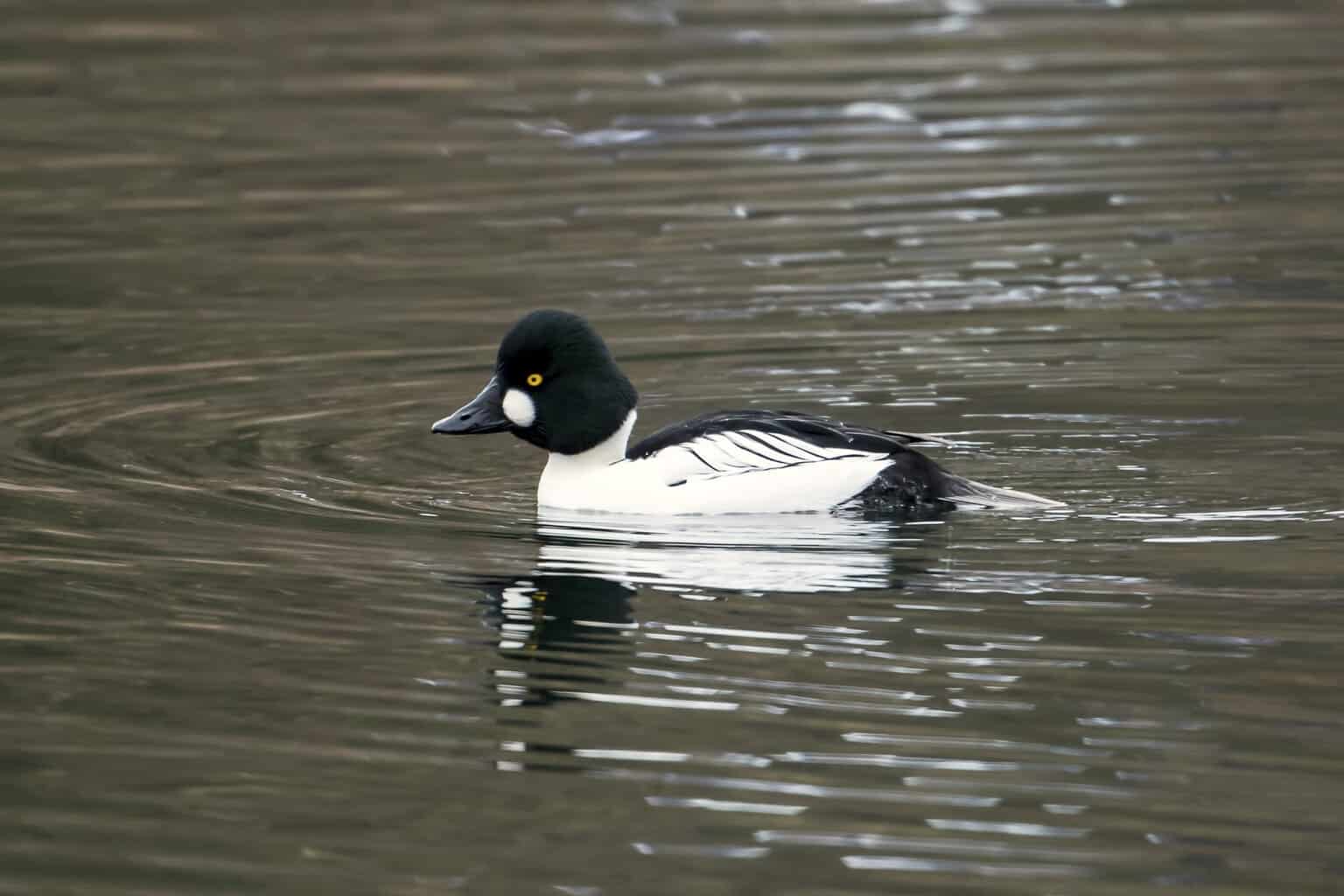
- Bucephala islandica
- Length: 16 – 20 in (41 – 51 cm)
- Weight: 38.4 oz (1088 g)
- Wingspan: 30 – 32 in (76 – 81 cm)
New Mexico is the very southern tip of the winter range of the Barrow’s Goldeneye. They are unlikely to be spotted in most of the state, but they may be seen around Four Corners and north of Santa Fe.
The male Barrow’s Goldeneye has a very dark, purple head that looks black at a glance. He has a white crescent-shaped marking on his cheek, a black bill, and a row of white, square-shaped spots on his black wings.
The female’s body is dark gray, and she has a brown head with a white neck ring. She has an orange-yellow bill.
You can probably guess this from their name, but Barrow’s Goldeneyes have bright yellow eyes.
One interesting trait about Barrow’s Goldeneyes is that you will not find them in waters that are home to insect-eating fish. That would create too much competition for the insects that the Barrow’s Goldeneye eats as a major part of its diet.
Blue-Winged Teal Duck (Dabbling Duck)
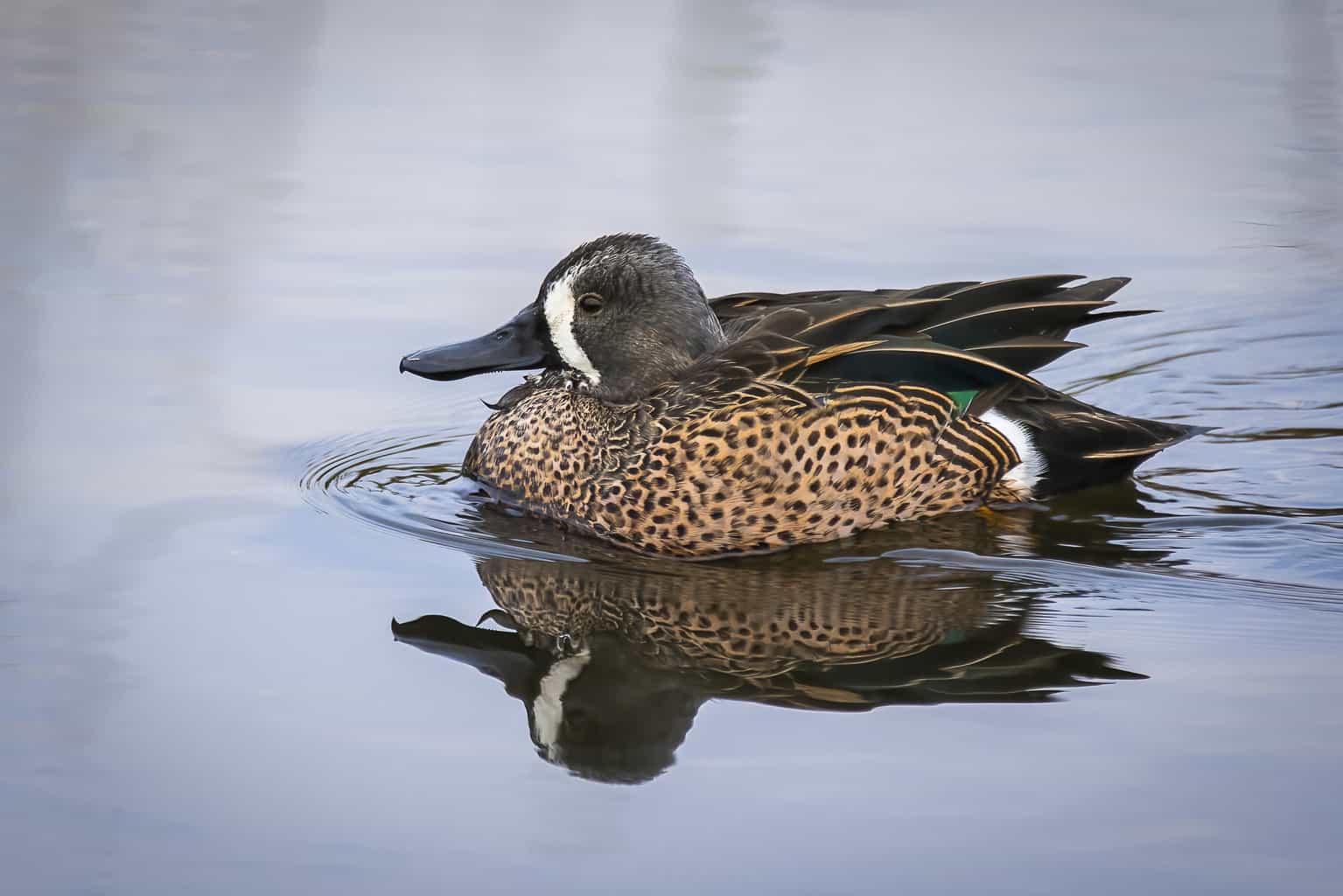
- Spatula discors
- Length: 15 – 17 in (38 – 43 cm)
- Weight: 19.18 oz (544 g)
- Wingspan: 23 -31 in (58 – 79 cm)
Whether or not you’ll see a Blue-Winged Teal Duck in New Mexico is dependent upon where you are and when you are there.
They are found throughout most of the state during the breeding season, which means you may get to see their hatchlings in the summer. However, they are not found in the southwest corner of the state, and they are rarely found anywhere in the state during the winter.
You can easily identify a male Blue-Winged Teal Duck from the large white crescent in front of his eyes. His head is bluish-gray, and he has a mottled brown body. The male’s back is black, and he has a blue shoulder patch and green speculum.
Females lack the same facial crescent. They look a lot like female Mallards, but they are smaller in size.
Blue-Winged Teal Ducks are hardy little ducks, but they also have very high mortality rates, probably because of how far they migrate every year. They also play a role in spreading avian influenza to New Mexico’s commercial poultry farms.
Bufflehead (Diving Duck)
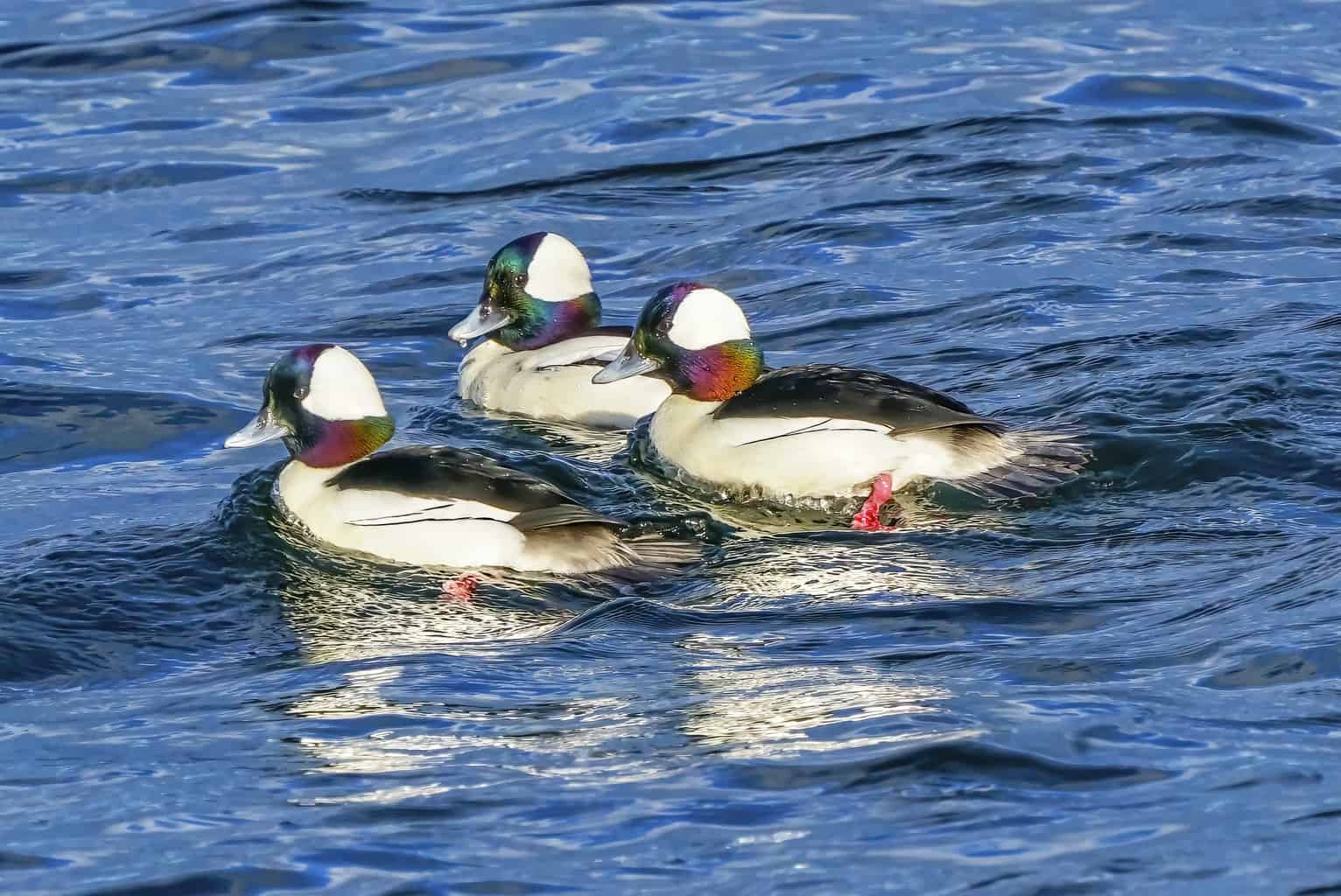
- Bucephala albeola
- Length: 13 – 16 in (33 – 41 cm)
- Weight: 21.16 oz (600 g)
- Wingspan: 21.6 in (55 cm)
Buffleheads are widespread throughout New Mexico during the winter. They begin to arrive in New Mexico in mid-October and then depart again between April and May. They make themselves comfortable in a variety of winter habitats, especially salty wetlands and bays.
Buffleheads are round-headed. The male has a tri-colored head: iridescent green, purple, and white. The rest of his body is black and white.
The female is shaped similarly, but her coloring is very different: a dark brown body, a pale gray breast, and a brown head.
Males and females alike are the smallest diving ducks in North America. They get their name from the word “buffalo,” since they have a fluffy, rounded head compared to the rest of the body — similar to the buffalo.
Buffleheads live in abandoned tree cavities, but they are also happy to build their nest sites in nesting boxes! You can buy one or build your own — check out our list of some of the best nesting boxes on the market.
Canvasback (Diving Duck)
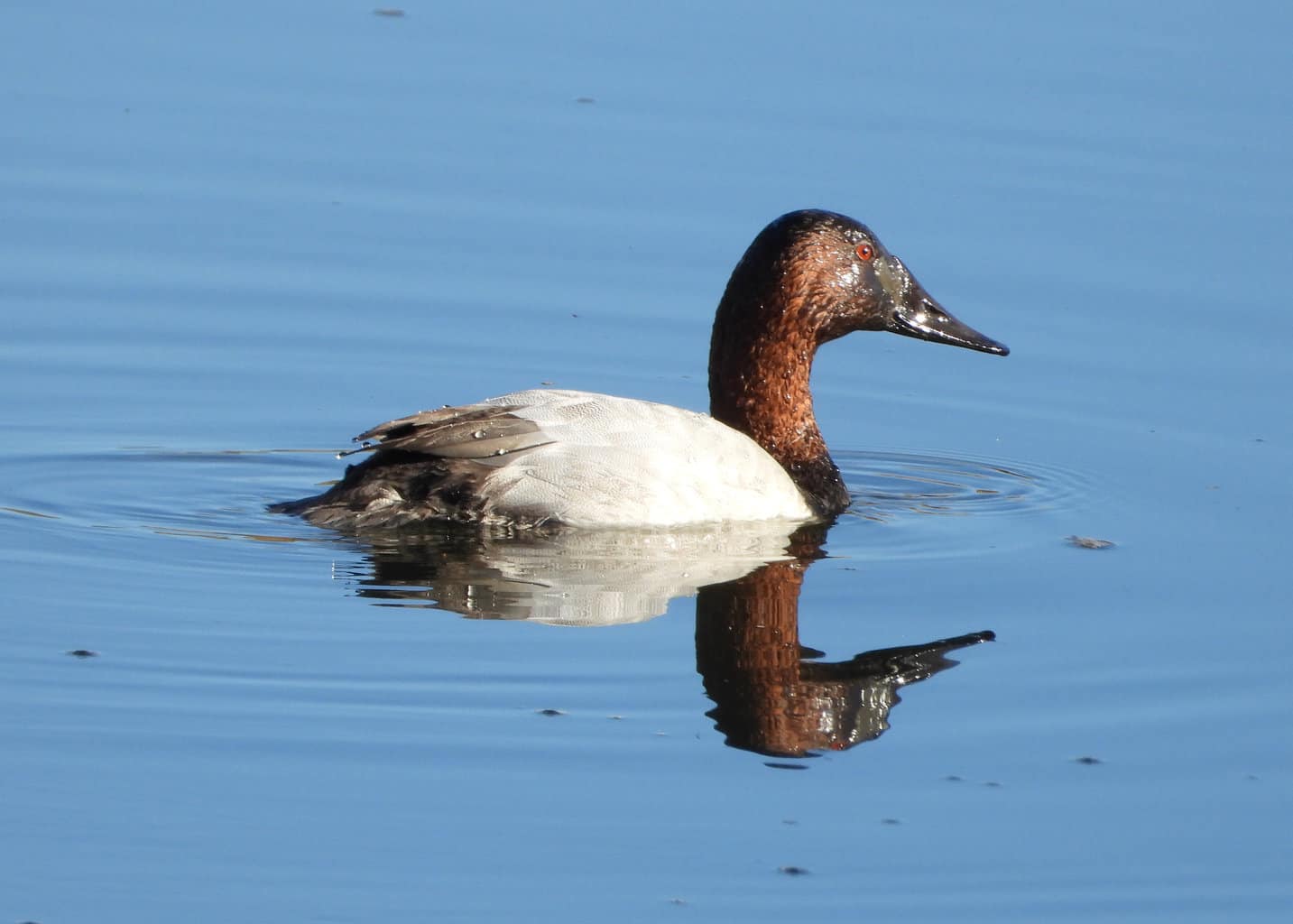
- Aythya valisineria
- Length: 19 – 24 in (48 – 61 cm)
- Weight: 58.48 oz (1657 g)
- Wingspan: 28 – 36 in (71 – 91 cm)
You might be noticing a pattern: many of New Mexico’s ducks are winter-season residents. That’s the case for Canvasbacks, certainly. They are found throughout the state all winter long, arriving in early fall and leaving again in early spring.
The Canvasback is North Carolina’s largest expert diving duck, weighing in at around 3.5 pounds.
The male has a broad, sloping, dark red head and a canvas-colored body. He has a thick, black bill and black tail feathers. His eyes are dark red.
Females are very similar in appearance, but their coloring is more muted. The female’s eyes are black, not red.
Males and females tend to migrate to different habitats in the winter. According to researchers, the theory is that adult males may be stronger and more capable of thriving in extremely cold temperatures. This means that they are willing to stay in colder temperatures than females, who keep moving further south.
Additionally, females may choose to migrate to a different area than their male counterparts in order to avoid competing for resources and food.
Cinnamon Teal Duck (Dabbling Duck)
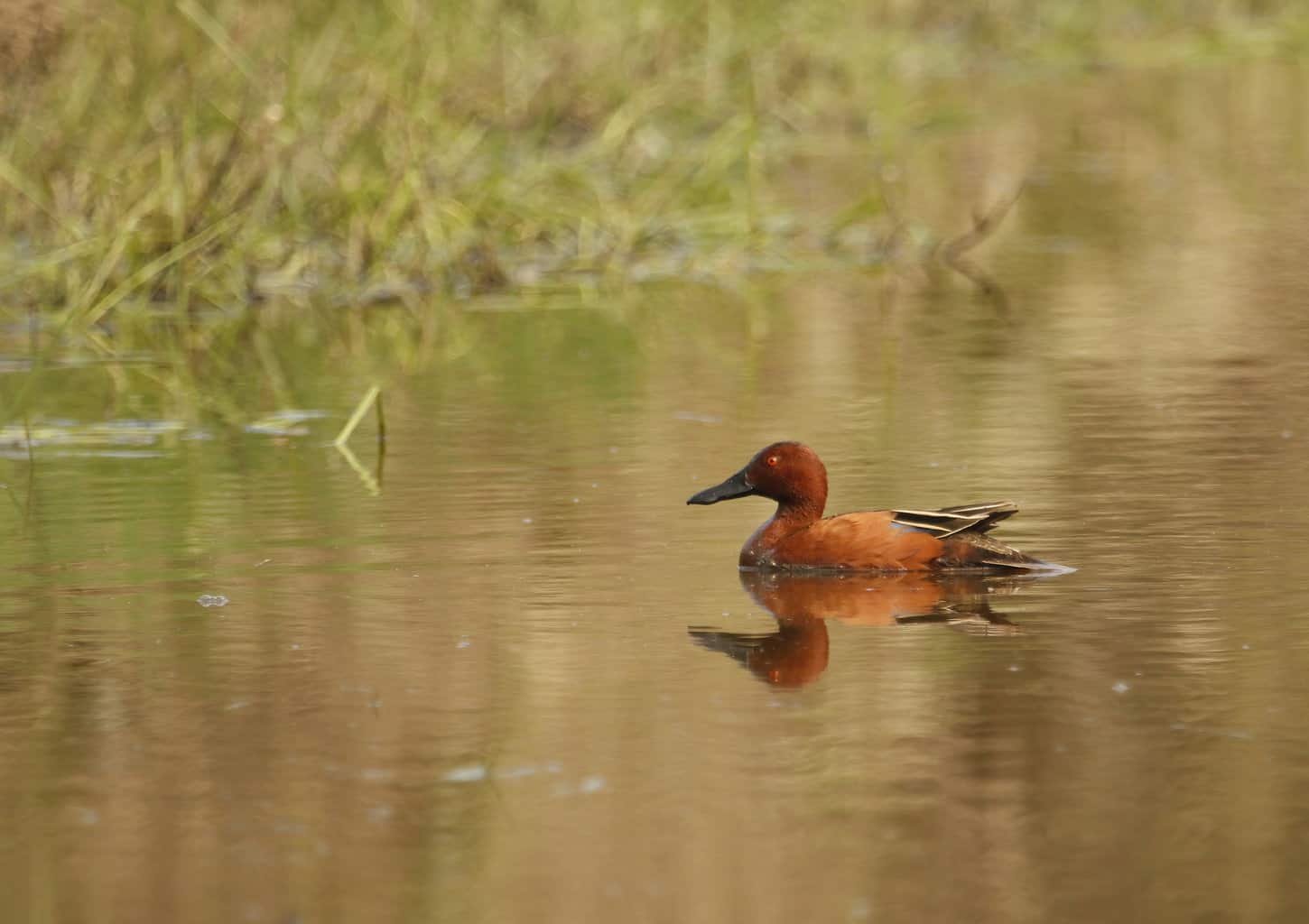
- Spatula cyanoptera
- Length: 11 inches
- Weight: 12.6-18.2 ounces
- Wingspan: 25 inches
Cinnamon Teal Ducks breed throughout much of the western United States, including most of New Mexico. However, they are year-round residents of the state’s southern border, including the Lincoln National Forest area.
During the breeding season, male Cinnamon Teal Ducks have a rust-red head, neck, and shoulders. The rest of their body is brown and black with green secondary feathers. Then, during the winter, their dark feathers are replaced by lighter ones.
Females and non-breeding males have dark and light brown feathers. Females also have a thick, black bill. Year-round, both males and females are excellent at camouflage.
They are relatively quiet ducks. Like with most duck species, the females are a bit noisier than the males. They make a quacking duck sound while males have a low, quiet chattering vocalization.
Common Goldeneye (Sea Duck)
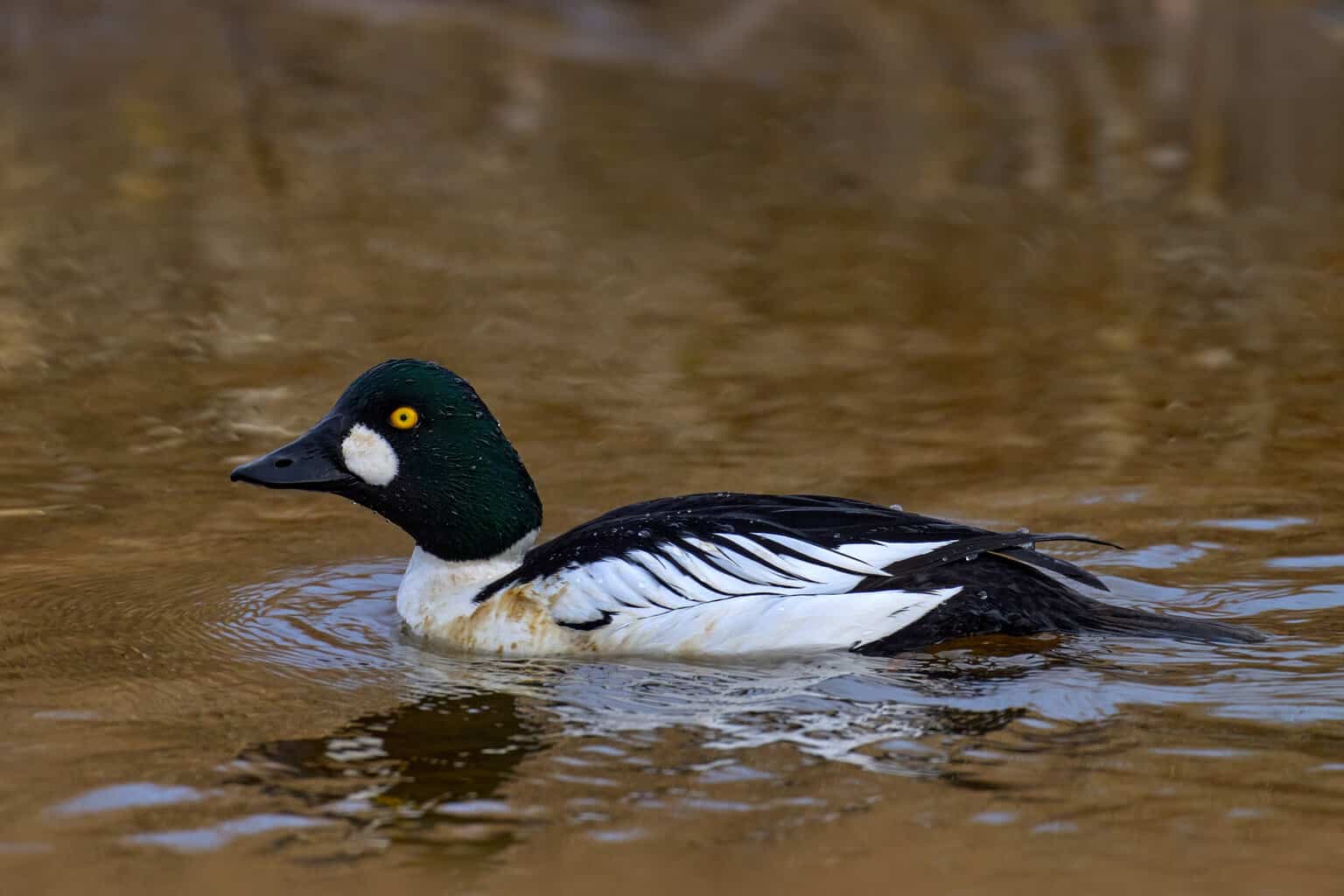
- Bucephala clangula
- Length: 16-20 inches
- Weight: Approximately 1.8 pounds
- Wingspan: 30.3-32.7 inches
Common Goldeneyes breed across Canada and winter throughout most of the US. They are widespread in New Mexico during the winter. Although they tend to winter on bays and estuaries in coastal states, they stay in shallow rivers and the edges of lakes in inland states like New Mexico.
The male Common Goldeneye is mostly black and white. His head is iridescent green, and he has white wing patches. His golden-yellow eyes are visible from a distance.
Females are brown, and they have black, yellow-tipped bills. They have dark brown heads.
These aggressive ducks fight with one another frequently. Females will often clash, causing their hatchlings to scatter. Sometimes, they are not able to find each other again, and so they end up finding a new nest with a new family of Goldeneyes.
Common Merganser (Sea Duck)
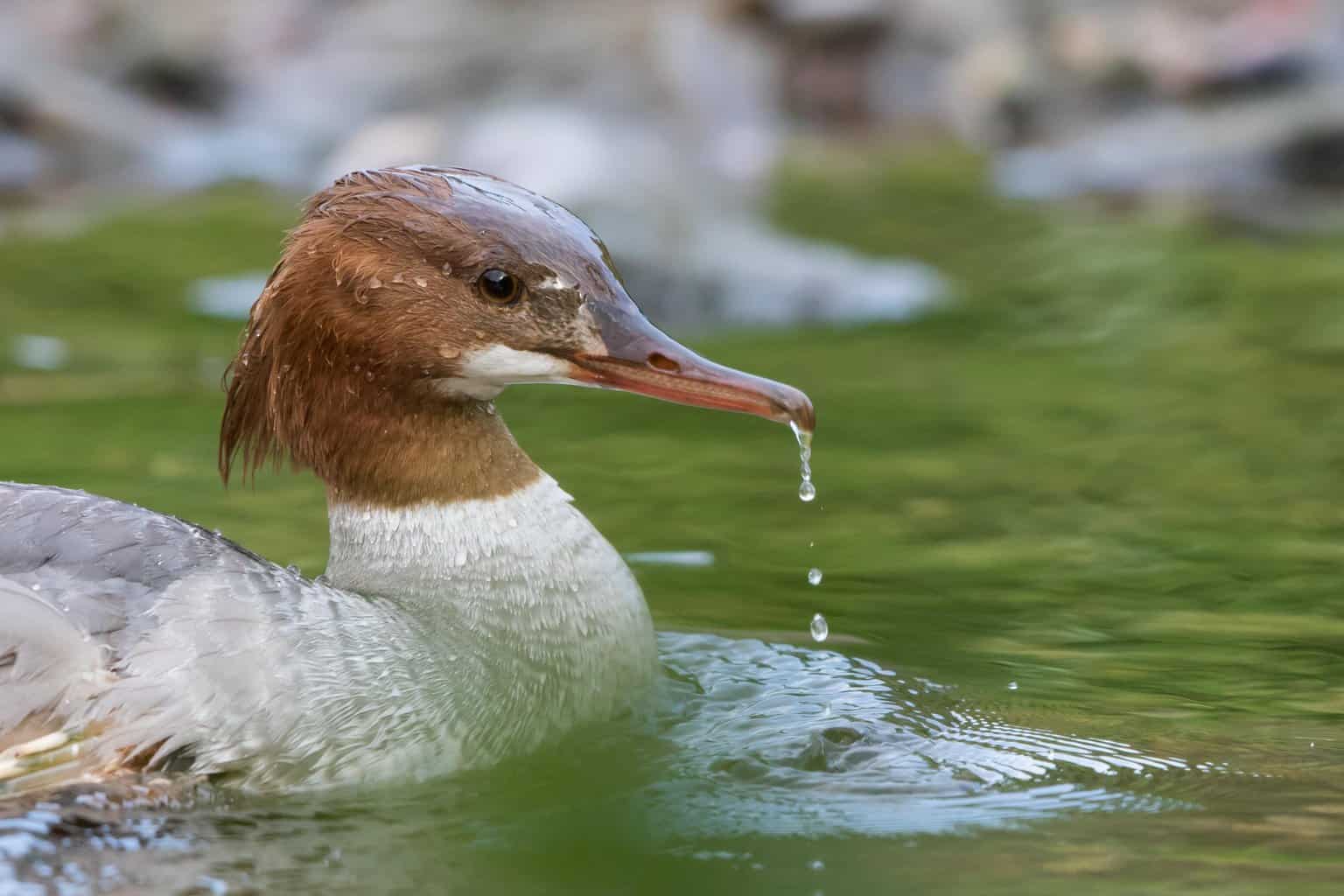
- Mergus merganser
- Length: 22 – 27 in (56 – 69 cm)
- Weight: 60.8 oz (1723 g)
- Wingspan: 31 – 37 in (79 – 94 cm)
Along with the Common Goldeneye and the Hooded Merganser, the Common Merganser is one of only three sea ducks that live in New Mexico. A sea duck is a type of diving duck that typically lives in a very deep body of water.
In New Mexico, the Common Merganser species is a winter resident in most of the state. Some will stay year-round along the northern border, near and in the Jicarilla Apache Nation Reservation.
Both male and female Common Mergansers have a striking, attention-grabbing appearance. The male Common Merganser’s head is dark, iridescent green. He has a white belly, black eyes, a black back, and a bright, serrated bill with a black tip.
The female has a dark reddish-brown head and a shaggy crest in the same color. The female’s belly and back are gray, and the breast is white.
Those long, serrated bills allow them to catch fish and rip them apart. They can use their strong bills to crack into hard mollusks, too. They also eat worms, frogs, insects, and small mammals.
Gadwall (Dabbling Duck)
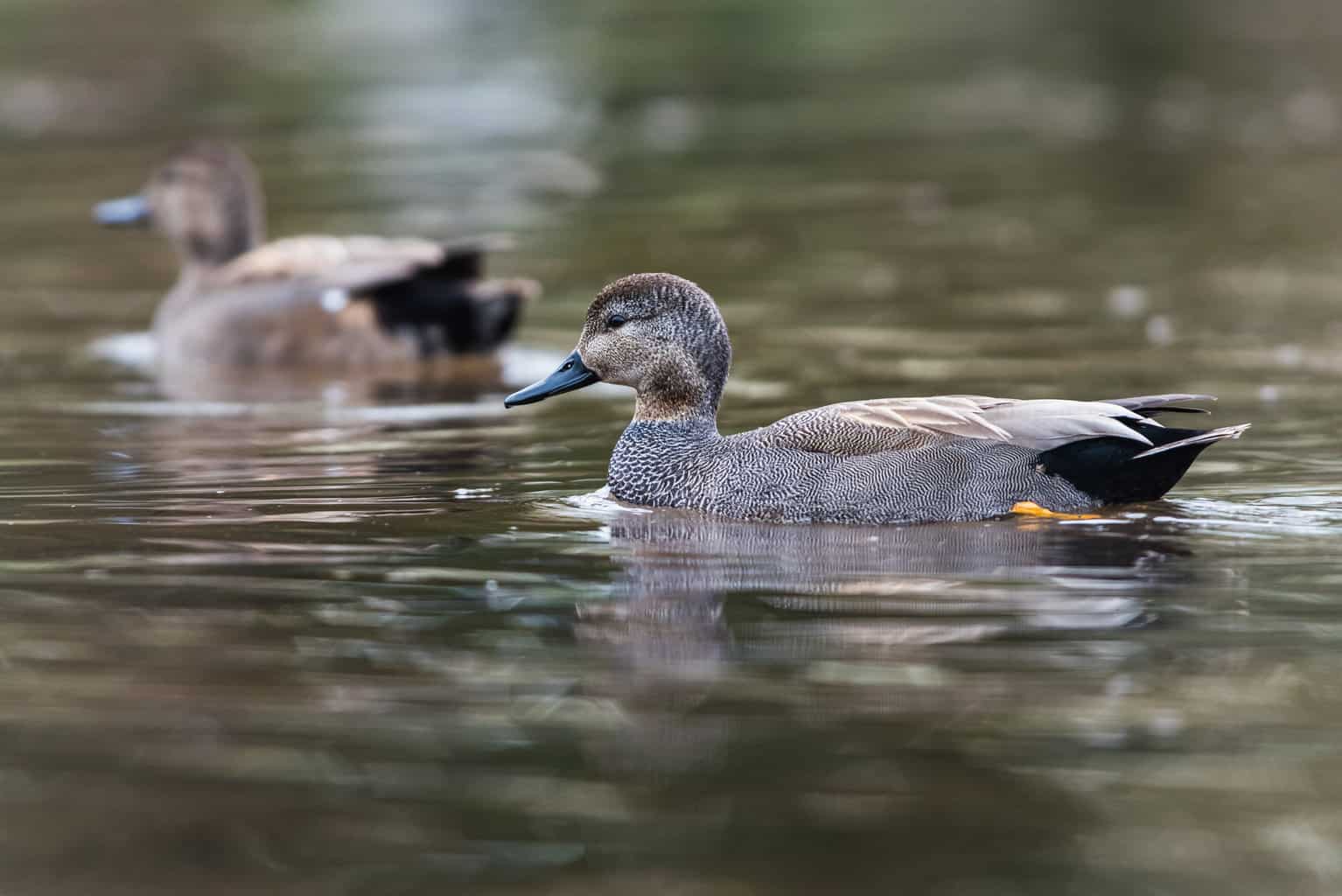
- Mareca strepera
- Length: 19 – 23 in (48 – 58 cm)
- Weight: 35.27 oz (1000 g)
- Wingspan: 31 – 36 in (79 – 91 cm)
Although most of New Mexico only sees Gadwall during the winter, they frequently breed along the Rio Grande down the middle of the state. That means they are found year-round along this river.
Male Gadwall have a delicate pattern of tiny scallops. His chest looks gray from a distance, and he has black tail feathers, a dappled brown head, and a black bill.
Females have a patchy brown appearance and an orange bill. Both males and females have white wing markings, but in general, they are unassuming in their appearance
Because Gadwall have incredibly high breeding success rates, they are incredibly common throughout North America. They are also excellent thieves! They will wait for other ducks to resurface with food and then steal it out of their bills.
Most of their diet is made up of submerged vegetation, but they also eat insects and insect larvae, shrimp, frogs, small fish, and crabs.
Green-Winged Teal Duck (Dabbling Duck)
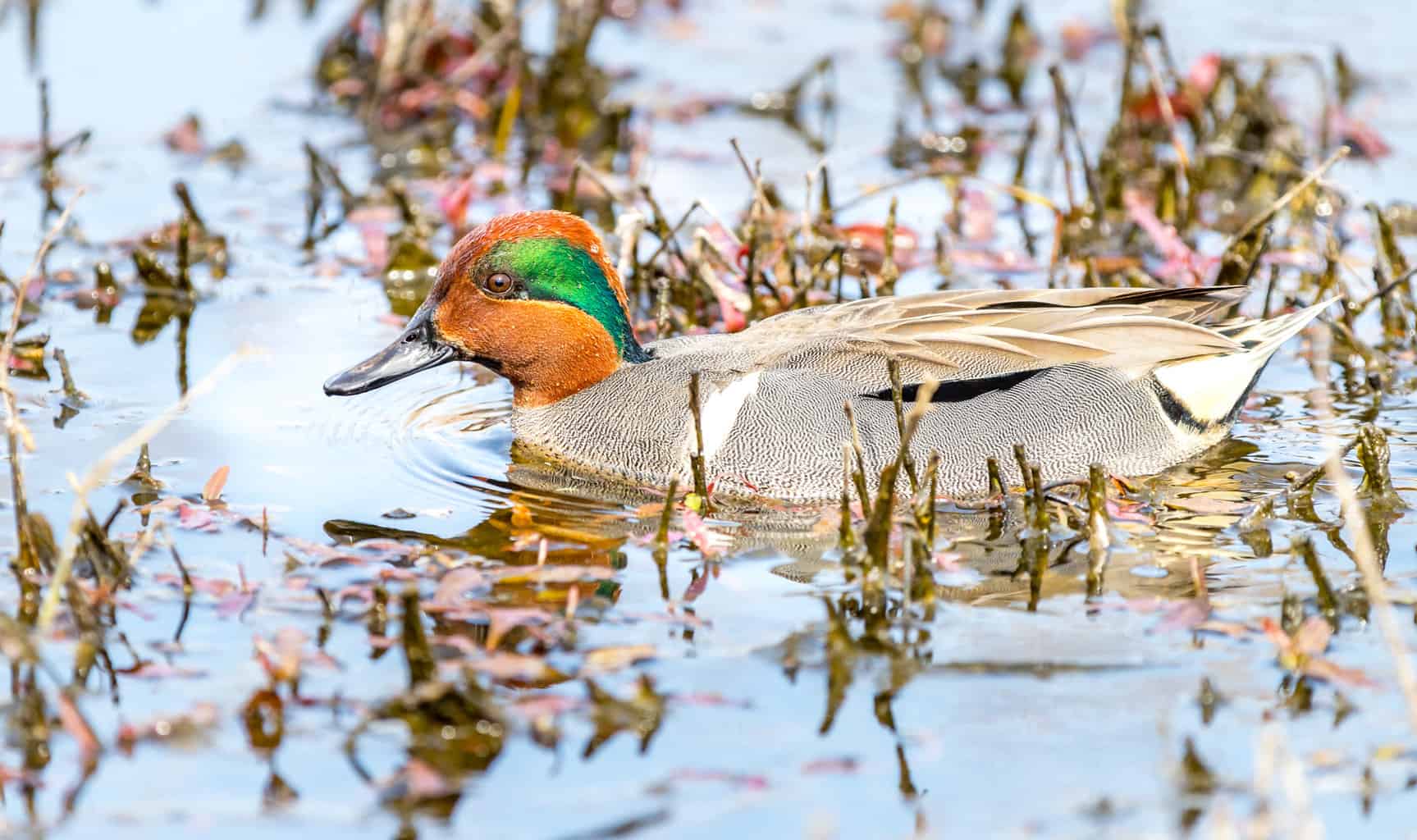
- Anas crecca
- Length: 12.2 – 15.3 in (31 – 39 cm)
- Weight: 4.9 – 17.6 oz (140 – 500 g)
- Wingspan: 20.5 – 23.2 in (52 – 59 cm)
New Mexico’s northern border is home to Green-Winged Teal Ducks all year, but most of the state only sees these small ducks in the winter. Their winter territory actually spans from Alaska and Newfoundland to South America, making these extremely widespread ducks.
Male Green-Winged Teal Ducks are easy to identify, thanks to the iridescent green stripe running from their eyes to the base of their neck. Otherwise, his body is mostly gray. He has a brown head and some brown coloring on his back.
Females vary from dark to light brown. They have a unique yellow stripe that runs along the length of the tail.
These ducks get their name from their iridescent green speculum, which both males and females have.
One of the most interesting things about a Green-Winged Teal Duck is its ability to take off in flight directly from the water! They don’t need a running start.
Hooded Merganser (Sea Duck)
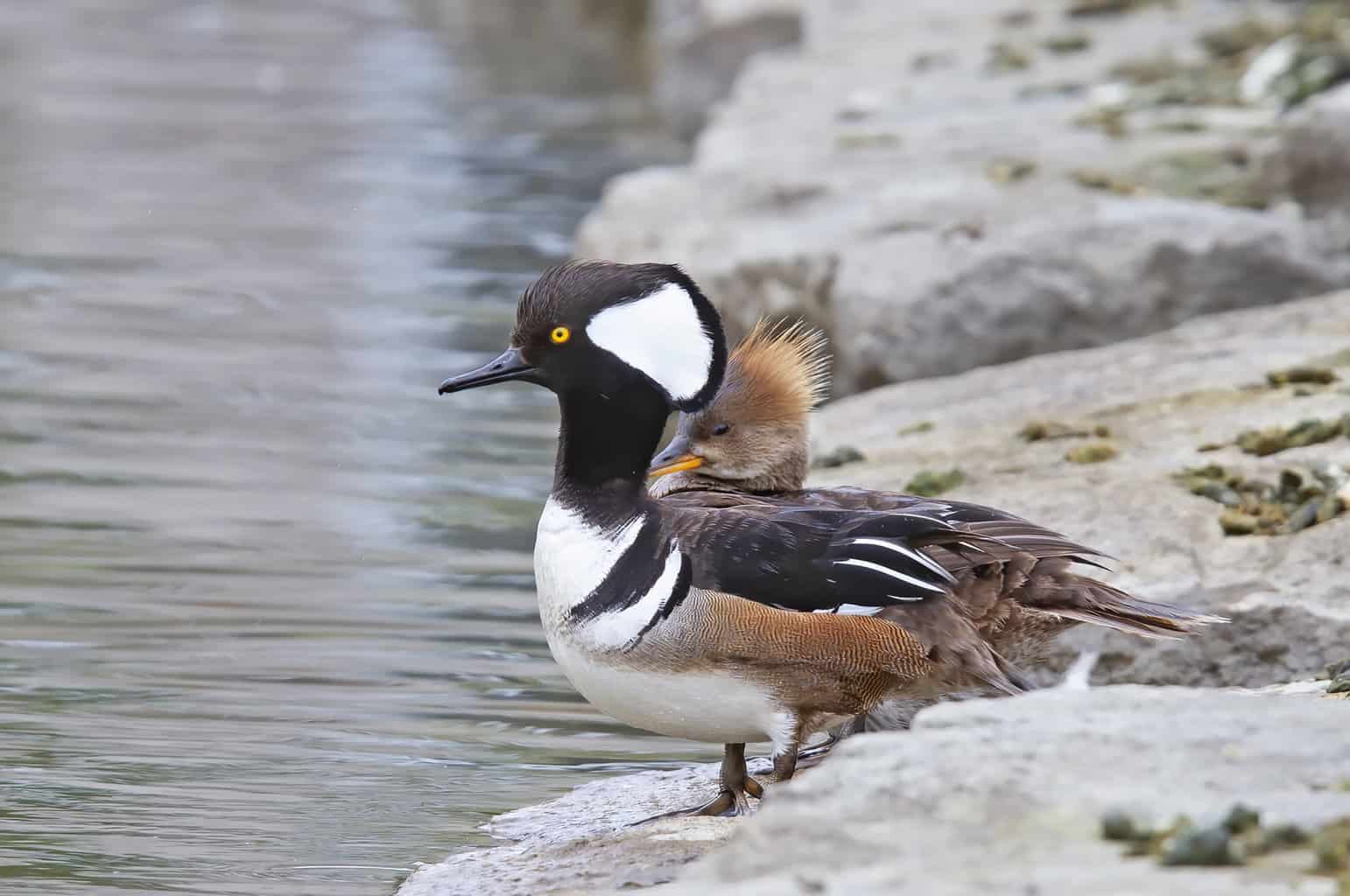
- Lophodytes cucullatus
- Length: 16 – 19 in (41 – 48 cm)
- Weight: 32.09 oz (909 g)
- Wingspan: 24 – 26 in (61 – 66 cm)
Hooded Mergansers are not found in most of New Mexico. That said, they migrate through the northeastern corner of the state on their way to their winter habitat.
Male and female Hooded Mergansers both have a crest. The male has a black and white crest. When he raises and lowers it, it changes the shape of the crest and the appearance of the white portion. They have black and white bodies, but their sides are brown.
The female’s cinnamon-brown crest is much shaggier. She doesn’t have many distinctive body markings, but you may notice some orange patterning on her long bill.
Hooded Mergansers have a nickname that comes from their vocalizations. They are called the Frog Duck because they sound like croaking pickerel frogs.
Lesser Scaup (Diving Duck)
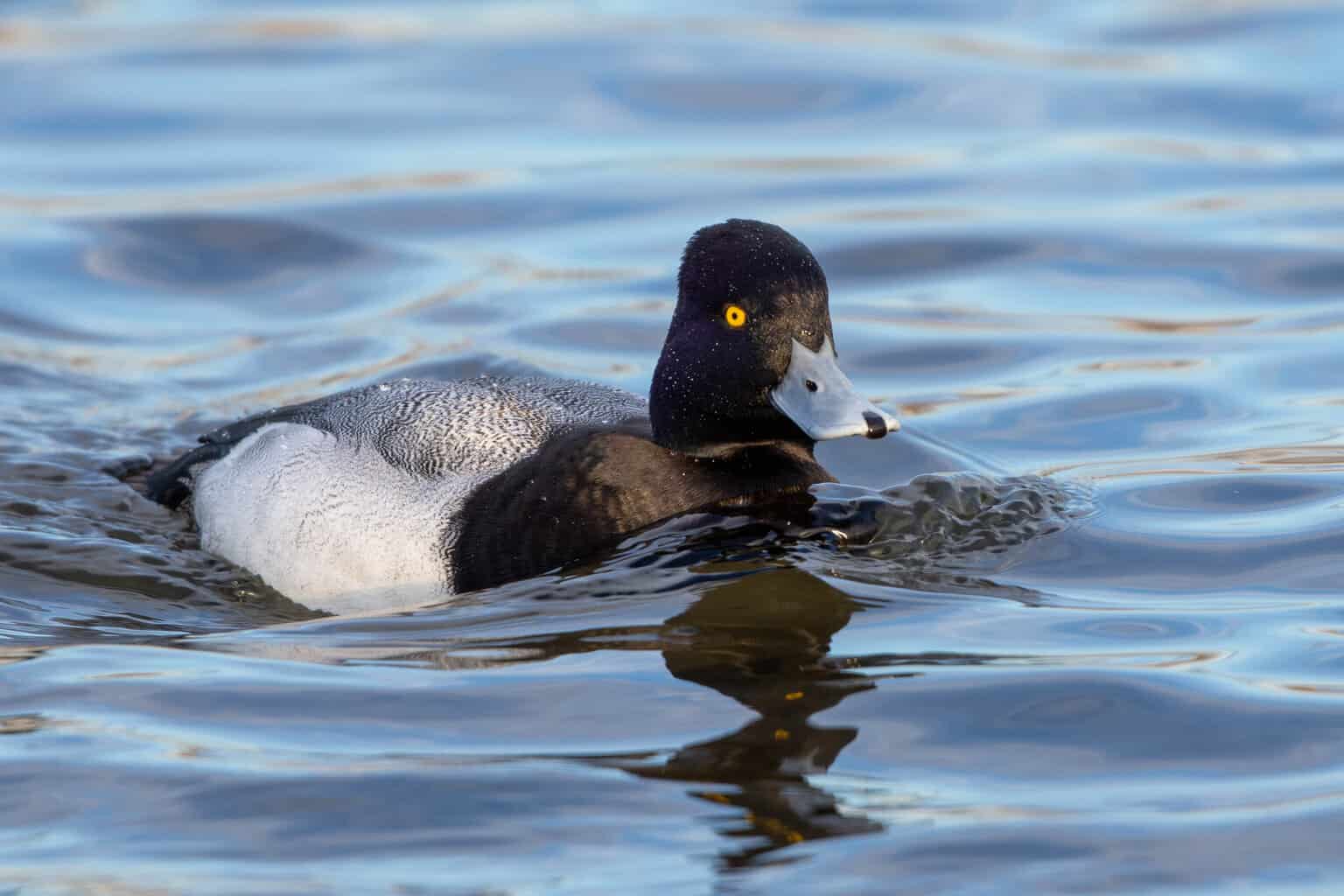
- Aythya affinis
- Length: 15 – 18 in (38 – 49 cm)
- Weight: 40.77 oz (1155 g)
- Wingspan: 24 – 33 in (61 – 84 cm)
There are two kinds of Scaup: Greater Scaup and Lesser Scaup. Many states are home to both of these species, which makes identifying them a challenge.
However, only Lesser Scaup live in New Mexico, so if you see a Scaup here, you can confidently identify it as a Lesser Scaup. If you divided the state across the middle, you’d find Lesser Scaup in the southern half of the state for the winter. In the northern half, they are only migratory visitors.
Their winter habitat typically includes coastal bays and estuaries, but in New Mexico, they tend to spend the season on unfrozen lakes and reservoirs,
Lesser Scaup males boast a dark, iridescent head that looks black from a distance, but is actually greenish-purple. The male’s body is covered in gray and white barring.
Females have dark brown bodies and a white patch on their face.
In addition to using camouflage as their primary defense mechanism, Lesser Scaup will also play dead to fool predators.
Mallard Duck (Dabbling Duck)
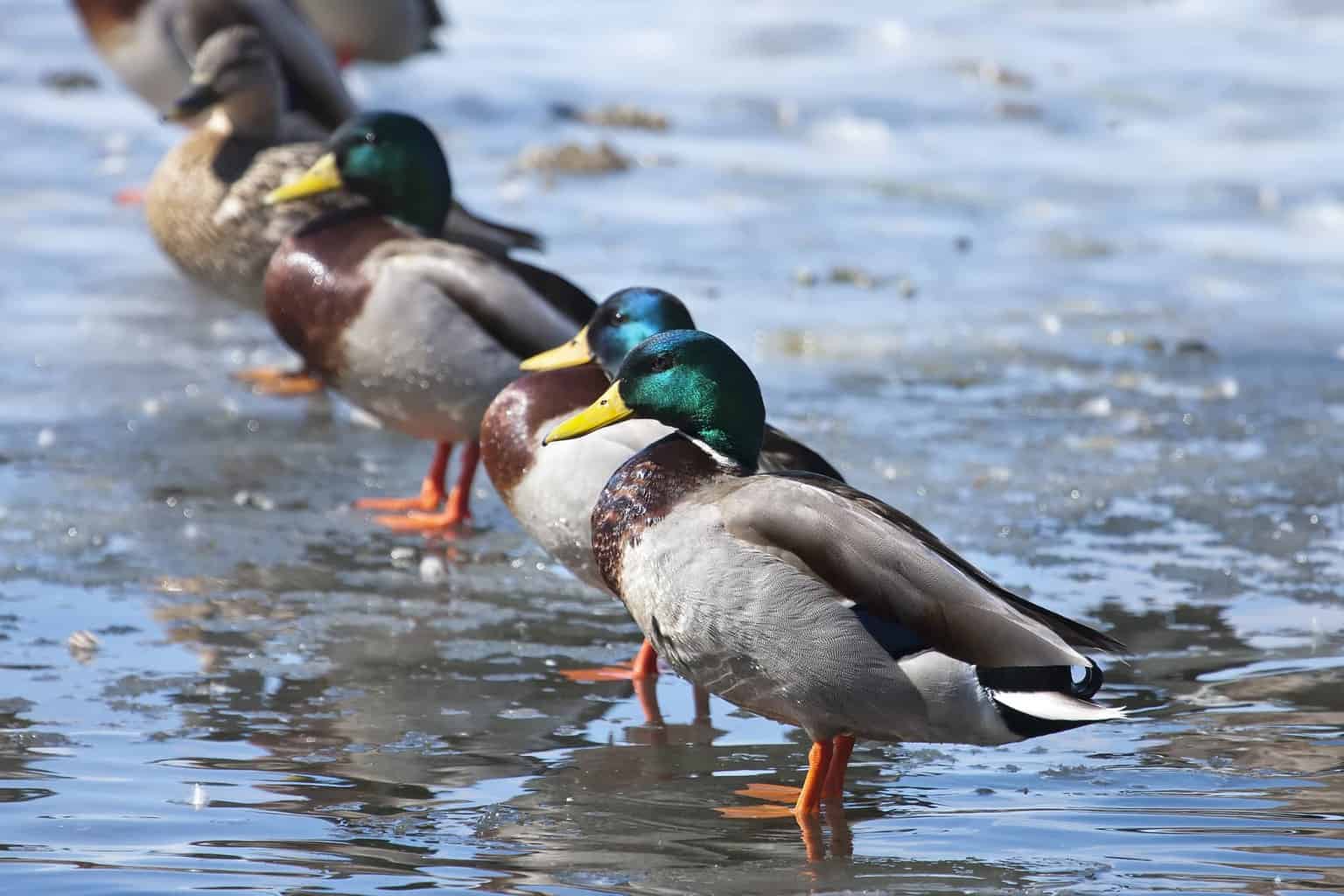
- Anas platyrhynchos
- Length: 19.7 – 25.6 in (50 – 65 cm)
- Weight: 35.3 – 45.9 oz (1000 – 1300 g)
- Wingspan: 32.3 – 37.4 in (82 – 95 cm)
Are there any ducks more iconic than the Mallard? They are found throughout the world, including Russia, Europe, parts of Asia, North America, and South America. They can be found year-round in most of New Mexico.
Male Mallards are stunning! The male’s head is iridescent green, and his body is mostly gray. He has a white neck ring, a baby blue speculum on his wings, a bright yellow bill, and a brown breast.
Females are speckled and streaked in brown. She has a light brown head and a multi-colored bill.
Mallards are not just prevalent throughout North America, but they are also prevalent in duck-themed decor. Perhaps that is because they are the world’s most populous duck.
Mexican Duck (AKA: Mexican Mallard) (Dabbling Duck)
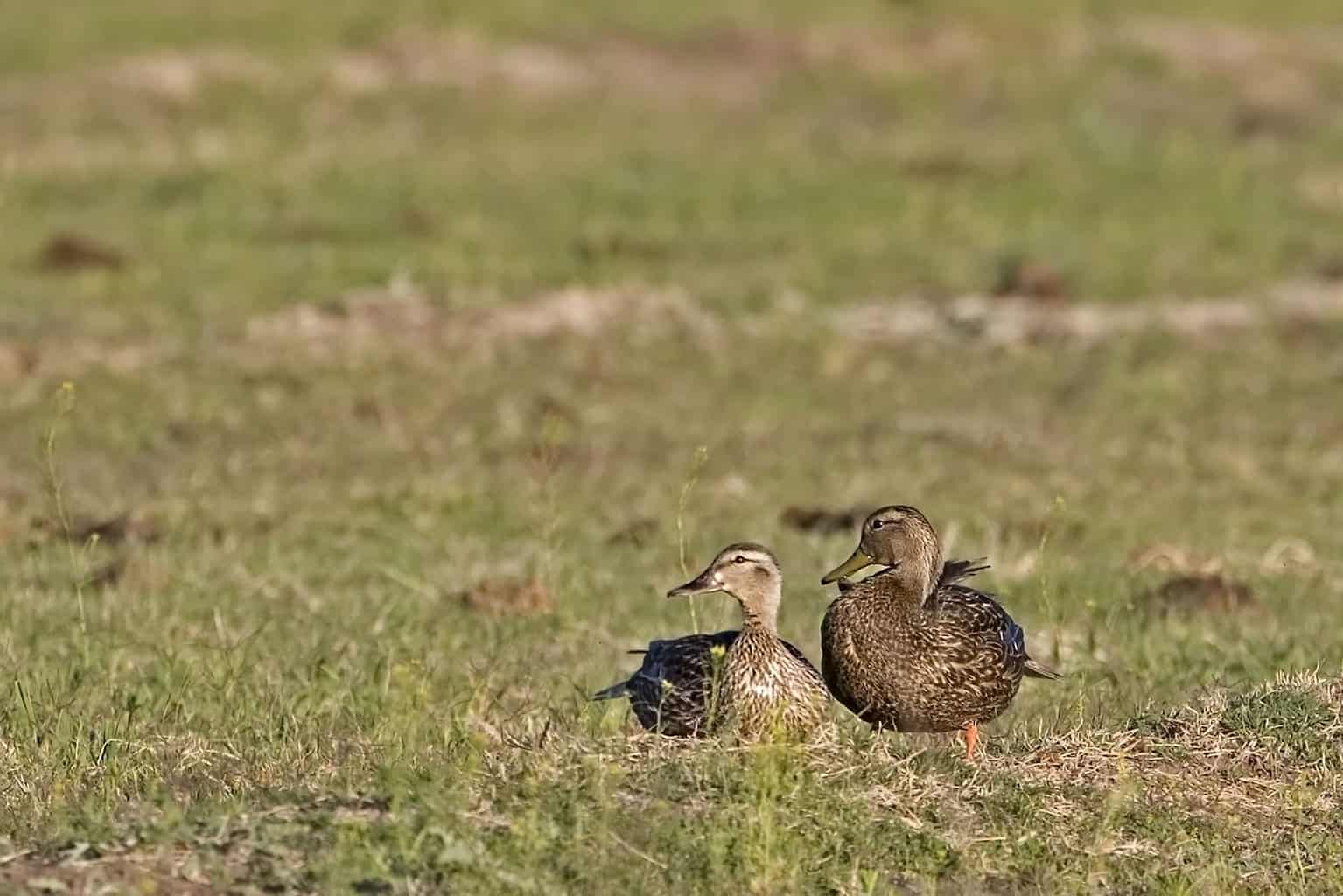
- Anas diazi
- Length: 20 – 22 in (51–56 cm)
- Weight: 1.98 lb (900 – 1100 g)
- Wingspan: 32 – 37 in (81.28 – 93.98 cm)
Mexican Ducks are a close relative of the Mallards that live in Mexico and parts of the southwestern United States. They are present in New Mexico year-round, mostly in the south and along the Rio Grande.
Unlike Mallards, who are strongly sexually dimorphic, Mexican Ducks of both sexes look pretty similar. They are very close in appearance to the female Mallard: brown and speckled.
Mexican Ducks are darker in color than Mallards. They have a blue speculum with white edges. The biggest difference between the male and the female is that his bill is brighter yellow than hers.
From 1983-2020, Mexican Ducks were categorized as a subspecies of Mallards. However, they have recently been re-classified as their own species, similar to the American Black Duck and Mottled Duck.
Their habitat includes freshwater marshes, lakes, ponds, and flooded agricultural fields. They will also breed and spend the winter on slow-moving rivers.
Northern Pintail (Dabbling Duck)
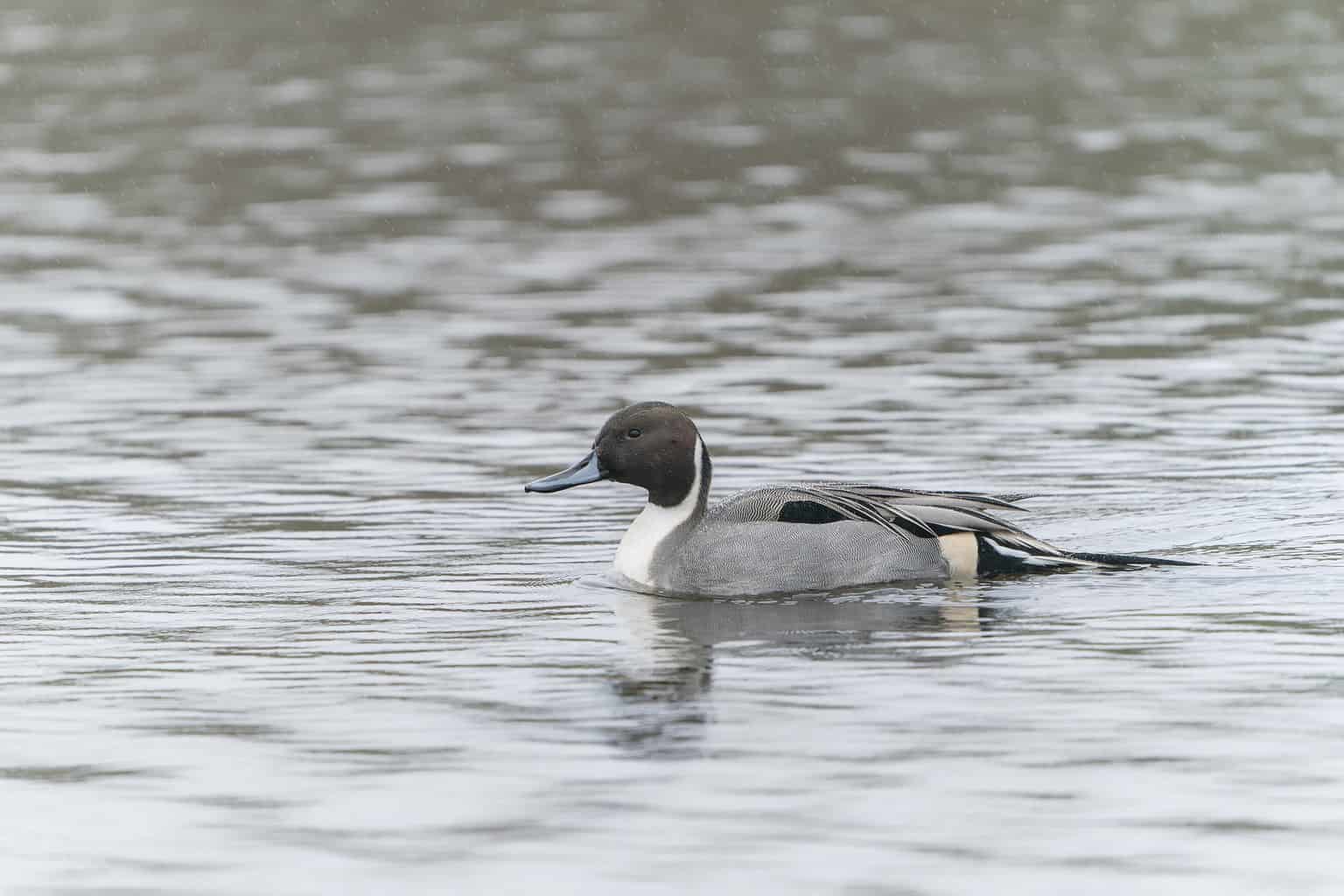
- Anas acuta
- Length: 20 – 26 in (51 – 66 cm)
- Weight: 36.33 oz (1030 g)
- Wingspan: 29 – 35 in (74 – 89 cm)
Northern Pintails visit pretty much every part of North America at some point in the year. They avoid the far northern Canadian tundra and Arctic Circle, but otherwise, they are widespread.
They spend the breeding season across Alaska, Canada, and the northern US, then migrate through the Midwest and New England. Their winter territory spreads from California to the East Coast and down to the southern tip of Mexico.
In New Mexico, they are common winter residents. Around Taos, some will stick around all year.
Male Northern Pintails are easily identified by their long, pointy tail feathers in the summer. Unfortunately, this identifying feature drops off for the winter, which is when you are likely to see them in New Mexico. Even so, their tail remains quite pointed — just not as long.
He has a gray body that is marked in brown, white, and black. He has a dark brown head and a white stripe running along his neck.
Females have short, pointed tails, and their body is covered in a brown-scaled pattern.
They are known for being fast flyers, reaching speeds of up to 48 miles per hour.
Northern Shoveler (Dabbling Duck)
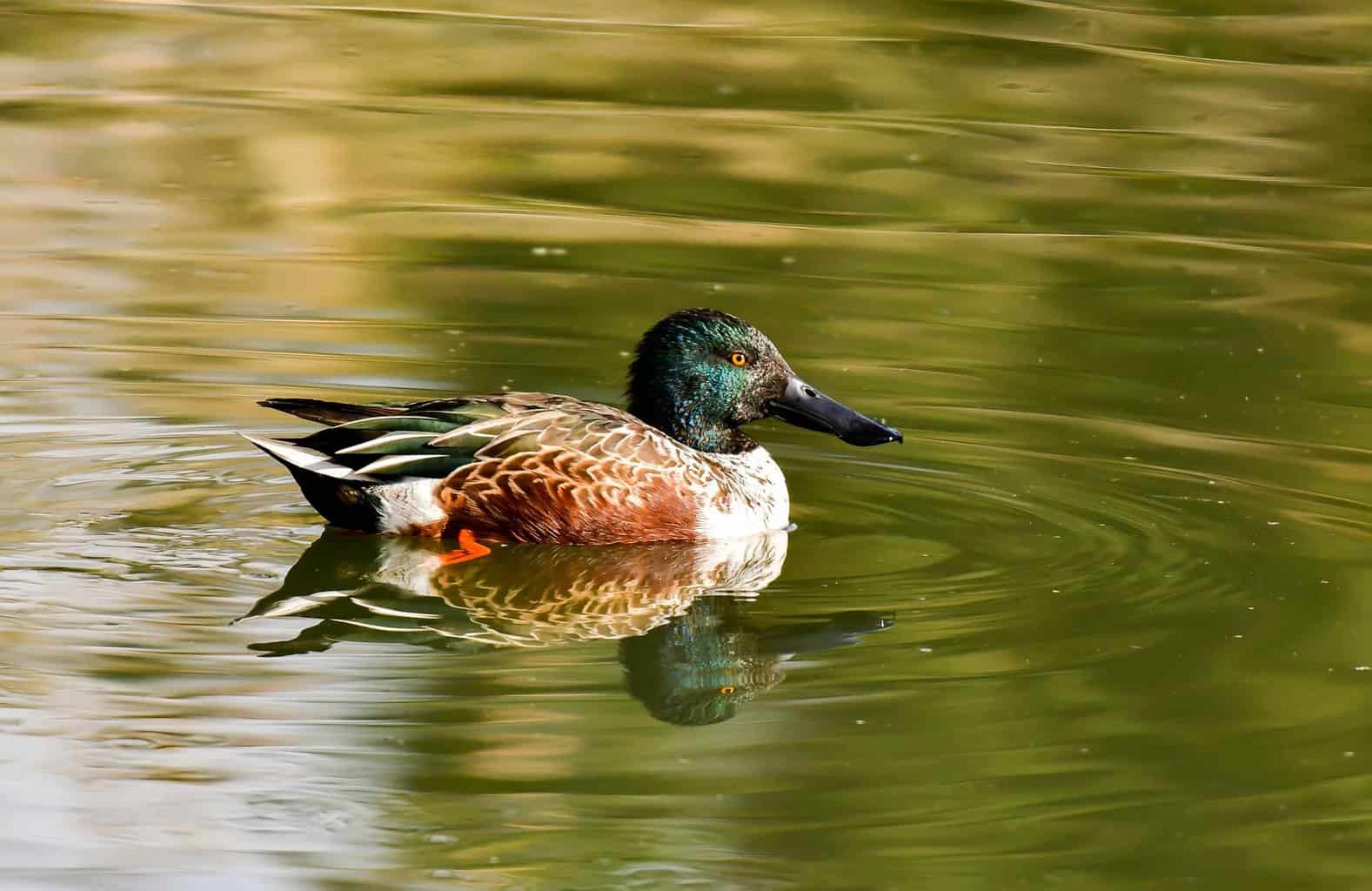
- Spatula clypeata
- Length: 17.3 – 20.1 in (44 – 51 cm)
- Weight: 14.1 – 28.9 oz (400 – 820 g)
- Wingspan: 27.2 – 33.1 in (69 – 84 cm)
Northern Shovelers live year-round along the Rio Grande and near Roswell in New Mexico, and they visit the rest of the state in the winter. Their winter habitat includes grassy wetlands.
They can also be found in rice fields, flooded agricultural fields, sewage lagoons, and shallow lakes and wetlands.
At first glance, the male Northern Shoveler may look a bit like a male Mallard, thanks to his stunning, iridescent green head. His sides are brown, and the rest of his body is mostly gray. He has a much thicker bill than the Mallard.
The female’s bill is orange, as are her legs. She has a dark brown head and a coarsely patterned brown body.
Northern Shovelers use a kind of gross defense mechanism to protect their nests. They defecate on their eggs when they are startled by a predator, and so their nests are often covered in feces.
It may be gross to us, but that is the point! They want to cause predators to turn away from the mess.
Redhead Duck (Diving Duck)
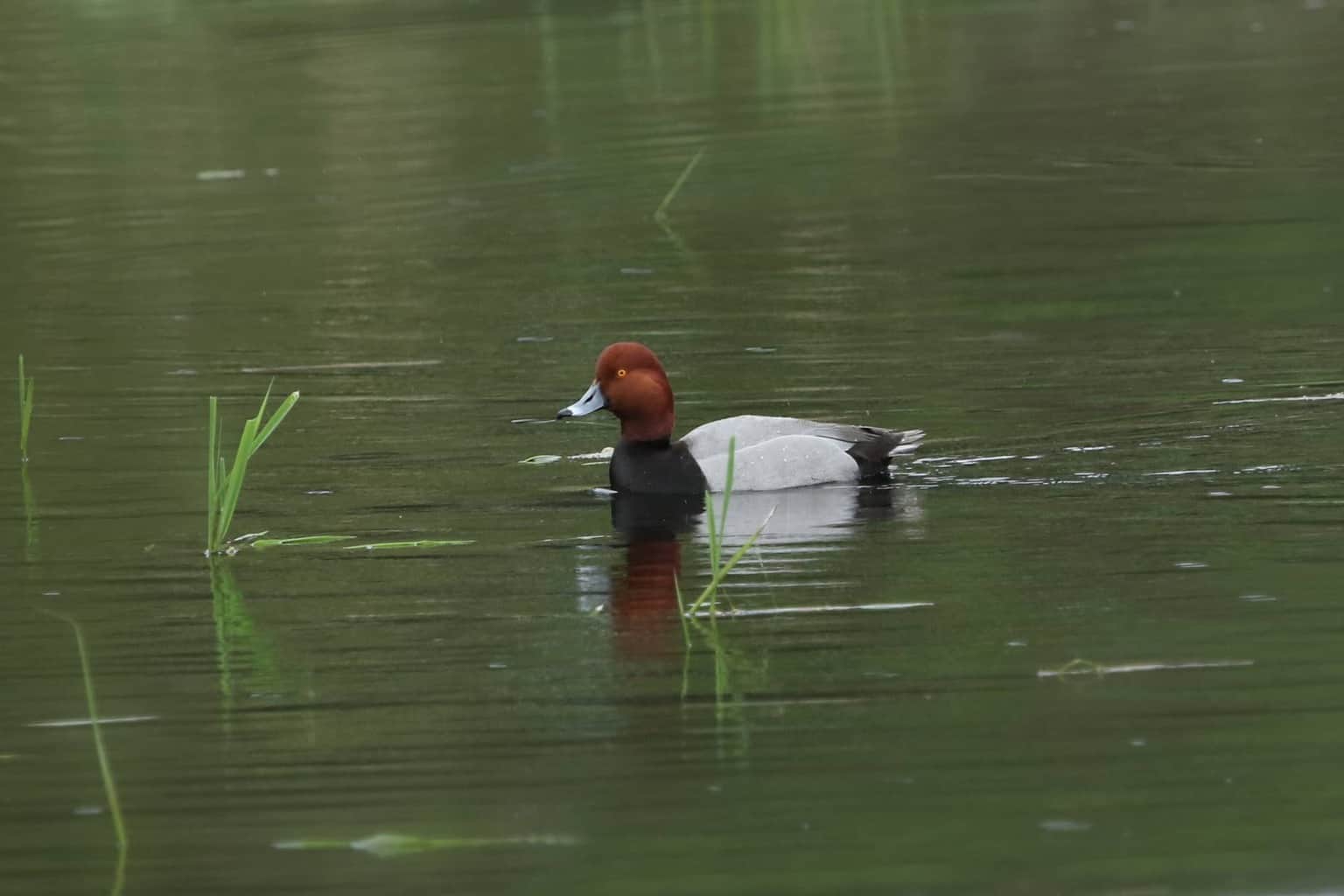
- Aythya americana
- Length: 18 -22 in (46 – 56 cm)
- Weight: 43.03 oz (1219 g)
- Wingspan: 29 – 35 in (74 – 89 cm)
Redhead Ducks are found in New Mexico during the winter. Just to the east in Texas, there is an area where they are year-round residents. In coastal states, they winter on coastal bays and estuaries, but in New Mexico, they are mostly found on freshwater lakes.
Male Redheads are brown-headed with a black-tipped gray bill. There is a strong contrast between the sections of his body: his sides and back are gray, but his chest is black.
Female Redheads look completely different from males. They have very few discernable markings and are instead all brown and very plain. They also have a black-tipped gray bill.
Redheads occasionally practice brood parasitism, where they lay some of their eggs in other ducks’ nests. This behavior is pretty fascinating, and it is a bit hard to predict whether a Redhead will lay eggs in her own nest, another Redhead’s nest, or both.
There seems to be a trend that when conditions are good and there is plenty of their favorite food and water, they are less likely to practice parasitism. During harder seasons, they will lay their eggs in other nests as a way of reproducing without taking on the burden of feeding their own young.
Ring-Necked Duck (Diving Duck)
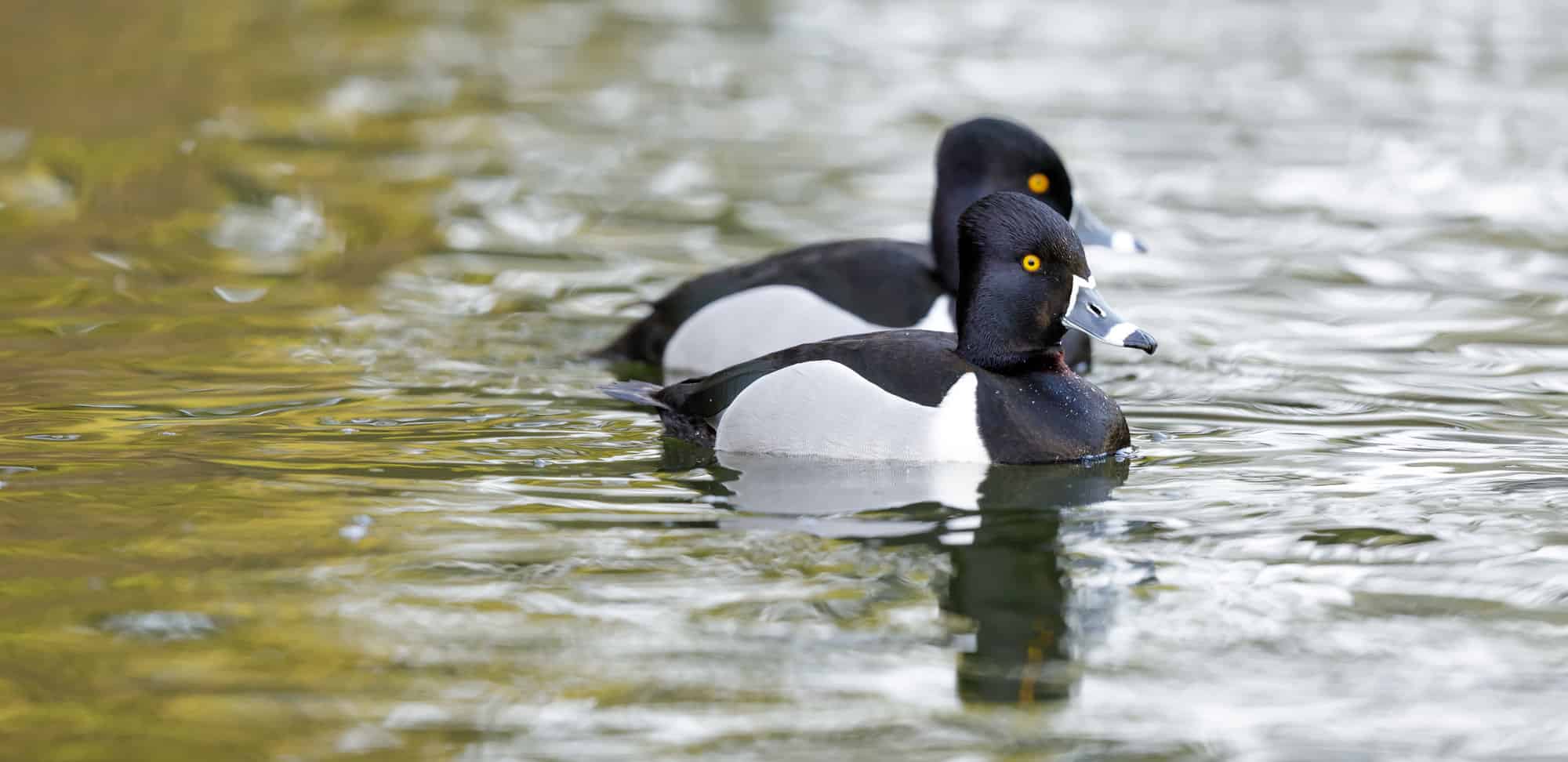
- Aythya collaris
- Length: 14 – 18 in (36 – 46 cm)
- Weight: 32.09 oz (909 g)
- Wingspan: 24 – 30 in (61 – 76 cm)
Ring-Necked Ducks are another winter resident of New Mexico. Like many other ducks that visit the state in the winter, their breeding territory stretches across central Canada.
Look for them in small lakes and ponds, beaver ponds, marshes, and flooded agricultural fields and cattle ponds.
Even though their name implies a visible ring around the neck, the copper-colored ring that gives the Ring-Necked Duck its name is barely visible, even if you are able to see it up close. From a distance, it’s completely indistinguishable.
Male Ring-Necked Ducks do have a white band around their bill, near the tip, and a thin white line that outlines the base of the bill near the face. His body is black and his sides are gray.
Females are brown. They do have the white band on their bill, but they don’t have the ring around the base of the bill. However, their face is pale near the base of the bill.
Ring-Necked Ducks do something that few other duck species do: they stay with their young until they are ready to fly. Most ducklings become independent very quickly, but Ring-Necked Ducks stay close to their young.
Ruddy Duck (Diving Duck)
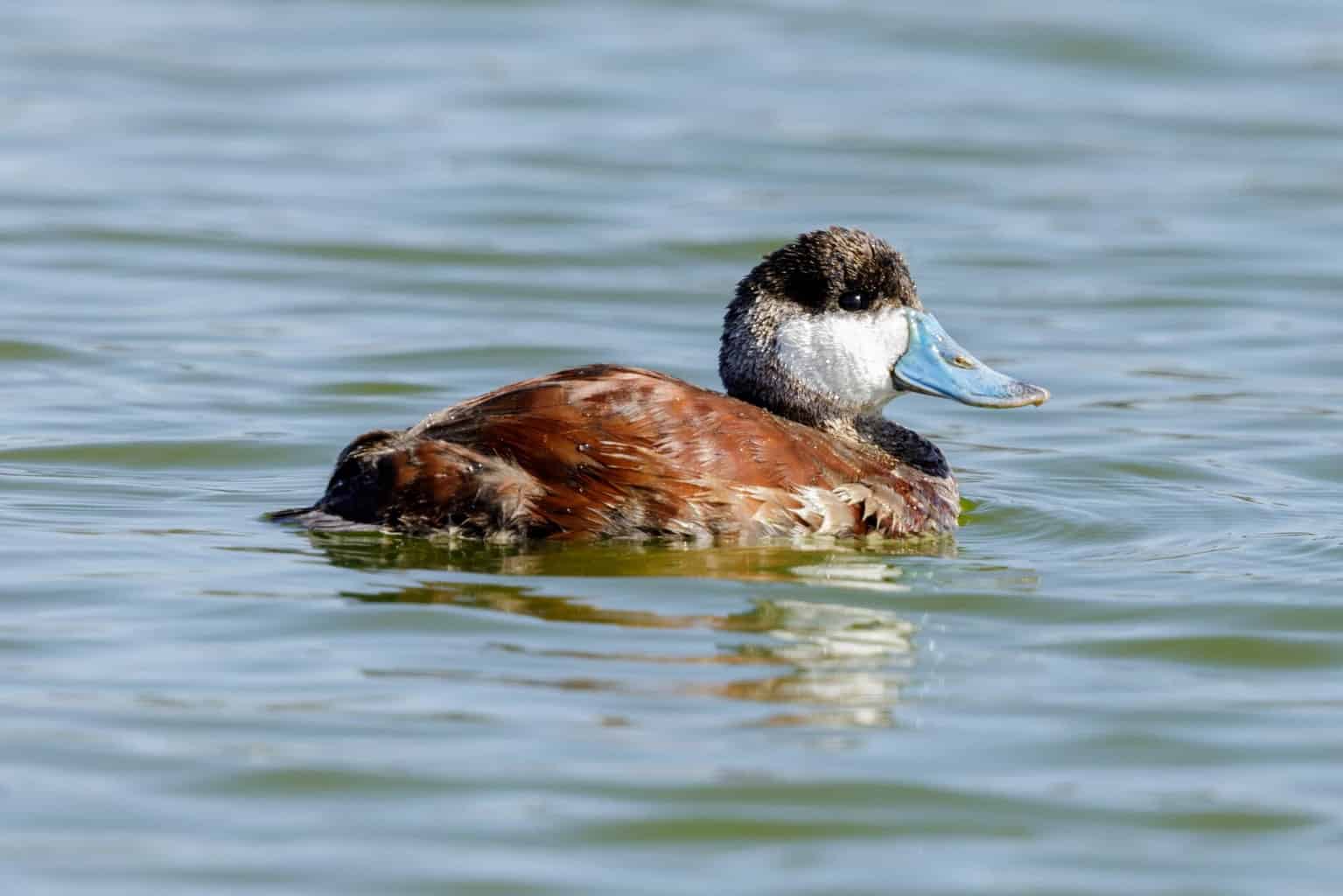
- Oxyura jamaicensis
- Length: 14 – 16 in (35.56 – 40.64 cm)
- Weight: 28.04 oz (795 g)
- Wingspan: 21 – 24 in (53 – 61 cm)
Ruddy Ducks are year-round residents of central New Mexico. They breed in the northern half of the state and spend the winter in the southeast corner. Their breeding habitat is made up of fresh marshes, ponds, and lakes.
Breeding season male Ruddy Ducks are dark brown with black heads. They have a large white patch on their cheeks and a thick, wide blue bill. After they molt for the fall, their overall coloring is dull gray.
Females are dappled in brown, and they have a gray patch on their cheeks. Their broad bill is black instead of blue.
There is a big difference between how Ruddy Ducks are perceived in the US vs. the UK. In North America, they are a native species that is quite common and inconsequential in most conservationist spaces. However, in the UK, they are a problematic invasive species.
They were introduced to the UK in the 1930s-1940s as captive ducks. When some individuals escaped, they began to thrive in the 1950s.
The problem is that they are so successful at interbreeding with the native White-Headed Duck that they are threatening the White-Headed Duck’s survival.
Today, European communities are trying to eradicate wild populations of Ruddy Ducks to protect other native species.
Wood Duck (Dabbling Duck)
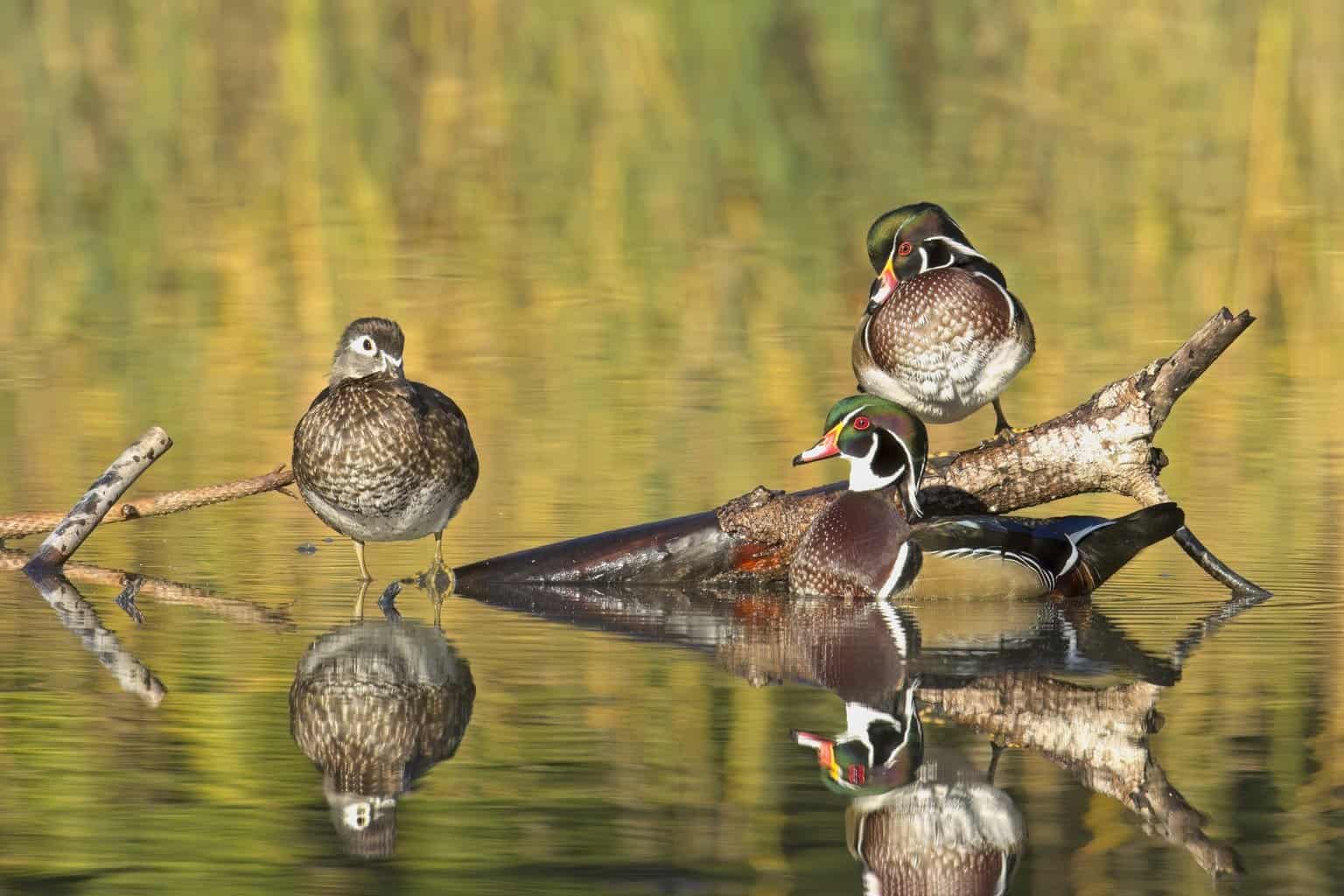
- Aix sponsa
- Length: 18.5 – 21.3 in (47 – 54 cm)
- Weight: 16.0 – 30.4 oz (454 – 862 g)
- Wingspan: 26.0 – 28.7 in (66 – 73 cm)
Wood Ducks are among the first ducks to leave their northern breeding habitats, which means they arrive earlier in New Mexico than other ducks who winter here. They are found throughout the state, usually in wooded wetlands.
The male Wood Duck has dramatic coloring: buff sides, chestnut brown breast, iridescent green head, multi-colored bill, and white stripes all over his body. He also has a long crest that angles downward toward the back of his neck.
The female Wood Duck has a gray head and brown body. She has a smaller crest. Perhaps the most striking thing about her is her eyes, which are outlined in white.
Wood Ducks are cavity dwellers who prefer dead trees, abandoned woodpecker holes, and nesting boxes.
They will not typically practice brood parasitism, but they will if their nests are too close together. This is true if someone puts up too many nest boxes in one area, too.
The Final Word on Ducks in New Mexico
Searching for, finding, and identifying ducks in New Mexico is a wonderful pastime!
Although there are fewer kinds of ducks in New Mexico than in many other states, there are still plenty of ducks to be found in the wetlands, inland lakes, rivers, and other waterways of the Land of Enchantment.
Of course, bird watchers are not limited to spotting ducks here! You can also find incredible birds here! Not all birds have the water needs of ducks, which means that even in New Mexico’s arid deserts, you’ll find plenty of birds that have the perfect adaptations for these areas.
Whether you live in New Mexico or are visiting, watch for the ducks that live here year-round or visit.
In most of the state, you will probably see more ducks in the winter than in the summer, but if you are near the Rio Grande, you should have many opportunities to see ducks year-round.
Collect your best birding gear (standard binoculars, compact binoculars, spotting scopes, a notebook and pencil, a good pair of shoes, and a birding guide) and head out to find some fascinating ducks in New Mexico!

